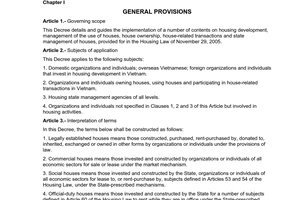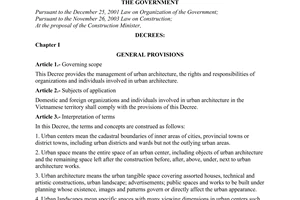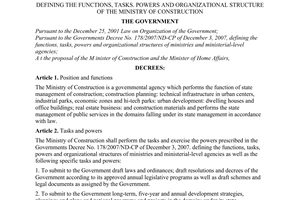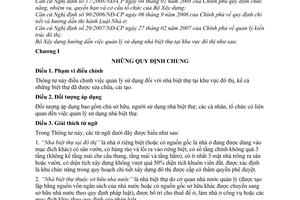Circular No 38/2009/TT-BXD guiding the use management of villas in urban centers đã được thay thế bởi Circular 19/2016/TT-BXD guidelines some content law on housing 99/2015/ND-CP và được áp dụng kể từ ngày 15/08/2016.
Nội dung toàn văn Circular No 38/2009/TT-BXD guiding the use management of villas in urban centers
|
THE
MINISTRY OF CONSTRUCTION |
SOCIALIST
REPUBLIC OF VIET NAM |
|
No. 38/2009/TT-BXD |
Hanoi, December 08, 2009 |
CIRCULAR
GUIDING THE USE MANAGEMENT OF VILLAS IN URBAN CENTERS
THE MINISTRY OF CONSTRUCTION
Pursuant to the Governments
Decree No. 17/2008/ND-CP of February 4, 2008, defining the functions, tasks,
powers and organizational structure of the Ministry of Construction;
Pursuant to the Government's Decree No. 90/2006/ND-CP of September 6,2006,
detailing and guiding the implementation of the Housing Law;
Pursuant to the Government's Decree No. 29/2007/ND-CP of February 27, 2007, on
management of urban architecture;
The Ministry of Construction guides the use management of urban villas as
follows:
Chapter I
GENERAL PROVISIONS
Article 1. Scope of regulation
This Circular regulates the use management of urban villas, including repaired or renovated ones.
Article 2. Subjects of application
The circular applies to villa owners and users; individuals and organizations involved in the use management of villas.
Article 3. Interpretation of terms
In this Circular, the terms below are construed as follows:
1. "Urban villa" means a separate residential house (or with origin as residential house and used for other purposes), which has yard, garden, fence, separate entrance, no more than three main floors (excluding the stairs-roofing floor, roofing floor and cellar), at least three sides facing the yard or garden, a construction area not exceeding 50% of the premises, determined as a functional area in the detailed planning on urban construction approved by competent authorities.
2. "State-owned villa" means a villa managed by a state body (built with state budget capital or being transferred to state ownership from another form of ownership under law), which is leased as a house or used as an official-duty house or for other purposes under law.
3. "State-owned villa-managing unit" means an organization tasked by a competent body to manage state-owned villas in the area.
4. "Villa owner" means an organization or individual lawfully owning all or parts of a villa.
5. "Villa user" means an organization or individual lawfully using a villa.
6. "Privately owned section" in villa means an area under private ownership of different owners in the villa with many owners, including:
a/ The area inside each room of the villa, including the balcony and loggia attached to that room;
b/ Other areas in the villa premises recognized to be under private ownership as provided for by law;
c/ System of privately used technical equipment attached to privately owned sections of the villa.
7. "Sections under common ownership" in a villa of different owners include:
a/ The remaining area outside the privately owned sections in the villa, defined in Clause 6 of this Article;
b/ The space and force-bearing system, common technical equipment in the villa, comprising force-bearing walls, walls surrounding the villa, partition walls, floors, roofs, common stair-cases, yard, garden, passages, corridors, common toilets, technical infrastructure system under common use and other sections not under private ownership in the villa;
c/ Technical infrastructure system outside the building but inside the villa premises.
Chapter II
USE MANAGEMENT OF VILLAS
Section I. GENERAL PRINCIPLES FOR USE MANAGEMENT OF VILLAS; RESPONSIBILITIES OF VILLA-MANAGING BODIES, OWNERS AND USERS; PROHIBITED A CTS IN THE USE OF VILLAS
Article 4. General principles
Villas must be managed under the following principles:
1. The management of villas must strictly comply with the provisions of law on planning, architecture, housing and the provisions of this Circular. For areas without a detailed planning on urban construction, upon the formulation of planning, villas of group 1 and villas of group 2 defined at Points a and b of Clause 2. this Article, must be included in the planning for management; for areas with a detailed planning on urban construction and villas of group 1 and villas of group 2 defined at Points a and b. Clause 2 of this Article already exist, those villas must be added to the planning for management.
2. Villas are classified into those of the following groups:
a/ Villas of group 1, which are villas associated with historical-cultural relics classified according to law on cultural heritage; villas of typical architectural value which are jointly determined, listed and submitted to provincial-level People's Committees (below referred collectively to as provincial-level People's Committees) for approval by competent provincial-level construction-architecture and culture bodies;
b/ Villas of group 2, which are those other than villas of group 1, but with architectural value which are jointly determined, listed and submitted to provincial-level People's Committees for approval by competent provincial-level construction-architecture and culture bodies;
c/ Villas of group 3, which are those other than villas of group 1 and villas of group 2.
3. For residential houses failing to meet the storey-height or construction density requirements but satisfying all remaining requirements defined in Clause 1, Article 3 of this Circular, and being associated to historical-cultural relics or of architectural value, provincial-level People's Committees shall consider and include them into the lists ofgroup-1 or group-2 villas mentioned at Point a or Point b. Clause 2 of this Article for management under this Circular.
4. The use management of villas must comply with the regulations prescribed for villas of the following groups:
a/ For villas of group 1, their architectural styles, original appearances and planning (construction density, number of storeys and height) shall be kept intact; for villas associated with classified historical-cultural relics, their use shall be managed under the law on cultural heritage;
b/ For villas of group 2, their outside architectural styles and planning (construction density, number of storeys and height) shall be kept intact.
5. State-owned villas shall be managed in accordance with regulations on management of houses and assets under state ownership.
6. Villas being official-duty houses shall be managed under the law on management of official-duty houses.
7. It is encouraged to thin out dwellers at villas with many households; to repair and renovate deformed villas back to their original architectural styles.
Article 5. Responsibilities of units managing state-owned villas
1. To manage the use of state-owned villas under this Circular and the laws on management of urban architecture, management of state-owned houses, management of official-duty houses; to inventory and scrutinize state-own villas for monitoring and management, not omitting any in order to avoid loss or waste;
2. To notify and guide villa users in complying with regulations on use management under this Circular;
3. To maintain villas assigned for management. If authorizing villa users to do the maintenance, they shall conduct inspection and supervision to ensure compliance with legal provisions on maintenance of constructions; to contact and coordinate with tree-managing agencies in listing and working out plans for protection, management and tending of secular trees in the premises of villas under their management:
4. To draw up plans for exploitation and use of state-owned villas with a view to ensuring their efficiency and avoiding waste and submit them to competent authorities for approval before implementing these plans;
5. To regularly inspect, detect in time and coordinate with competent state agencies in handling acts of violation in the use management of state-owned villas.
Article 6. Responsibilities of villa owners
1. To fully observe the principles stated at Clause 4, Article 4 of this Circular; to comply with the provisions of Articles 9 and 10 of this Circular;
2. To maintain privately owned villas or privately owned sections of villas with many owners; to contribute fully and on time funds for the maintenance of villa sections under common ownership;
3. To conduct or contribute funds to the sanitation and tending of trees and lawns in villa premises; to preserve secular trees in villa premises and contact tree-managing agencies for listing, protection, management and tending of those secular trees according to regulations;
4. To create favorable conditions for responsible persons to maintain villa sections under common ownership;
5. To strictly comply with regulations on fire and explosion prevention and fighting; to fight fires, to maintain public sanitation, security and order;
6. To restore the original state of. or pay compensation for damage they cause to, villa sections under common ownership or private ownership of other owners;
7. To detect and notify in time acts of violating the regulations on use management of villas to competent bodies;
8. Not to commit prohibited acts defined in Article 8 of this Circular.
Article 7. Responsibilities of villa users then than owners
1. To comply with the provisions of Clauses 1,4, 5, 6, 7 and 8, Article 6 of this Circular;
2. To tend trees and lawns, to clean inside the villa premises if so agreed upon with owners;
3. To repair or renovate villas only after it is so consented by villa owners or villa- managing units (if villas are under the state ownership).
Article 8. Prohibited acts in the use management of villas
1. Arbitrarily conducting demolition or renovation which alters villas' planning (construction density, number of storeys and height), architectural styles and original appearance, with regard to group-1 villas;
2. Arbitrarily conducting demolition or renovation which alters villas' planning (construction density, number of storey and height) and external architectural style, for group-2 villas;
3. Building annexes to, occupying the area and/or space of, or causing damage to assets in, sections under common ownership or sections under common use in all forms; arbitrarily chiseling, renovating, dismantling or altering the force-bearing sections, technical infrastructure system, equipment under common use or external architecture of villas; changing the structures and/ or designs of villa sections under private ownership or sections under private use;
4. Dividing or converting against regulations the villa sections under common ownership or sections under common use;
5. Causing noises in excess of the prescribed level, affecting villa order and security;
6. Littering or discharging wastewater, emissions and hazardous wastes wantonly; causing leakings and environmental pollution;
7. Making advertisements, inscriptions or paintings in contravention of regulations or committing other acts not permitted by law;
8. Using or letting other persons use sections under private ownership or sections under private use for improper purposes;
9. Raising cattle or poultry in villa sections under common ownership or sections under common use; raising cattle or poultry in villa sections under private ownership or sections under private use, thus affecting the villa order, beautiful view and the living environment of other households and public places (if pet animals are raised, legal provisions must be complied with);
10. Dealing in trades and commodities prone to cause fires or explosions (soldering, gas production or trading, explosive materials and other dangerous production and business lines);
11. Providing services which cause noises and environmental pollution (dance halls, car and motorbike repair; slaughterhouses and other polluting services);
12. Arbitrarily felling secular trees in villa premises.
Section 2. MAINTENANCE, RENOVATION AND RE-CONSTRUCTION OF VILLAS; VILLA MANAGEMENT DOSSIERS
Article 9. Villa maintenance
1. Villa maintenance must comply with legal provisions on maintenance of constructions; for villas associated with historical- cultural relics, their maintenance must comply with regulations on repair, renovation, preservation and restoration of relics under the law on preservation, renovation and restoration of historical-cultural relics and scenic places.
2. Villa owners and managing units shall maintain villas. If villa users other than villa owners wish to maintain sections under their private ownership, they shall get written consent of villa owners.
For villas with many owners, the owners shall maintain the sections under their respective private ownership and contribute funds to the maintenance of villa sections under common ownership to villa owners' representatives at the levels agreed upon among the owners. In case of absence of such agreement, the funds will be divided in proportion to area under each owner's private ownership.
3. The maintenance of villas (including group-1 villas, group-2 villas and group-3 villas) must comply with the provisions of this Circular, the law on planning and architecture management and the law on residential houses.
If the maintenance of group-1 villas involves a change of color or materials, it must be consented by provincial-level People's Committees after the provincial-level construction and architecture management bodies and culture management agencies give their comments.
4. Villa maintenance must ensure safety for humans and property as well as environmental sanitation.
Article 10. Renovation or reconstruction of villas
The renovation or reconstruction of villas (including group-1 villas, group-2 villas and group-3 villas) must comply the law on construction, planning and architecture management. Particularly for villas of groups 1 and 2, in addition to these regulations, the following provisions shall also be complied with:
1. For group-1 villas:
a/ The renovation must not alter the original utility and nature;
b/ Villas shall not be demolished (unless they are damaged and degraded, close to collapse as concluded by bodies competent to appraise the quality of constructions). In case of demolition for re-construction, the architectural style, original appearance and planning (construction density, the number of storeys and height) of the villas must be strictly preserved.
c/ For villas associated with historical-cultural relics, the renovation and reconstruction must strictly comply with the law on preservation, renovation and restoration of historical-cultural relics and scenic places;
d/ Additional structures of any materials must not be built to expand area or annexes must not be built to occupy space;
e/ Materials of different properties must not be used to replace the existing materials of villas. If different colors or materials are used or villa utility is altered, approval of provincial-level People's Committees is required after the provincial-level construction-architecture managing bodies and culture managing agencies give their comments.
2. For group-2 villas:
a/ The renovation must preserve their external architectural style;
b/ Demolition shall be conducted only when villas are damaged and degraded, close to collapse, as concluded by agencies competent to appraise the quality of constructions or when district-level People's Committees so approve after the district-level construction-architecture managing bodies give their comments; upon reconstruction thereof, their external architectural style must be strictly preserved and their planning (construction density, the number of storeys and height) must be strictly complied with.
Article 11. Villa management
1. Villa owners, villa-managing units or current users (if owners cannot be identified) shall compile and archive villa records and submit one copy to provincial-level managing bodies (for villas of group 1 or group 2) or district-level managing bodies (for villas of group 3).
For villas associated with historical-cultural relics, apart from the submission to the above-defined bodies, the villa records shall also be submitted to competent bodies managing historical-cultural relics in localities where exist those villas.
2. Villa shall records be made under Clause 3, Article 66 of the Housing Law, and be enclosed with their photos showing the exterior of villas.
3. Villa record-managing agencies shall supply villa documents to concerned bodies upon request.
Chapter III
SETTLEMENT OF DISPUTES AND HANDLING OF VIOLATIONS
Article 12. Settlement of disputes
1. Disputes over villa ownership will be settled by court.
2. Disputes over the use rights in state-owned villas will be settled by provincial-level house-managing bodies.
3. Disputes over civil contracts in the course of performing the use management of villas under this Circular will be handled according to the law on civil contracts.
Article 13. Handling of violations
1. Acts of violation of this Circular shall be handled under the law on handling of violations in house use management, planning and architecture management.
2. Those who abuse positions and powers to act against the regulations on use management of villas shall, depending on the severity of their violations, be administratively handled or examined for penal liability. If causing damage, violators shall pay compensation therefor.
Chapter IV
IMPLEMENTATION ORGANIZATION AND IMPLEMENTATION PROVISIONS
Article 14. Responsibilities of provincial-level People's Committees
1. To promulgate relevant regulations on management of villas in their localities according to this Circular lo suit the practical local situation.
2. To direct concerned agencies to study for promulgation and publicization the lists of villas in their localities under Points a and b. Clause 2, Article 4 of this Circular for use as a basis for use management of villas.
3. To promulgate mechanisms to encourage organizations and individuals to participate in preserving and renovating villas of groups 1 and 2 as provided lor at Points a and b. Clause 2, Article 4 of this Circular; to repair, renovate deformed villas for restoration of their original architecture; to annually review and assess the use management of villas in localities and report thereon to the Ministry of Construction.
4. To make commendations and handle violations according to their competence.
Article 15. Responsibilities of provincial-level Departments of Construction
1. To advise provincial-level People's Committees on performing the state management of villas in localities; to assume the prime responsibility for. and coordinate with concerned bodies in, determining the lists of villas of group 1 and group 2 under Points a and b. Clause 2, Article 4 of this Circular and submit them to provincial-level People's Committees for approval.
2. To guide slate-owned villa-managing units to inventory and scrutinize state-owned villas in their localities and draw up plans on effective exploitation and use of state-owned villas and submit them to provincial-level People's Committees for adoption before implementing these plans.
3. To closely coordinate with concerned bodies in inspecting and urging the implementation of this Circular in their respective localities.
4. To annually report to provincial-level People's Committees and the Ministry of Construction on the use management of villas in the localities.
Article 16. Responsibilities of the House and Real Estate Market Management Department
1. To assume the prime responsibility for, and coordinate with relevant functional bodies in, guiding the implementation of this Circular;
2. To sum up concerned bodies' reports on arising problems and study and propose appropriate amendments and supplements to this Circular;
3. To coordinate with local functional bodies and concerned organizations and individuals in organizing training in the use management of villas nationwide.
Article 17. Effect
1. This Circular takes effect on January 22, 2010.
2. Difficulties and problems arising in the course of implementation shall be promptly reported to the Ministry of Construction for consideration and proper amendments and supplements.-
|
|
FOR
THE MINISTER OF CONSTRUCTION |




